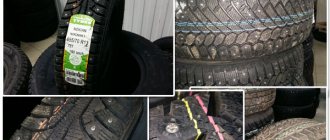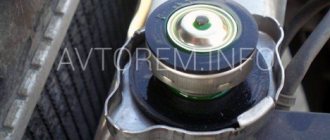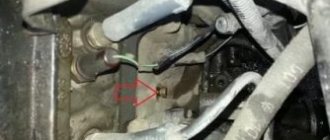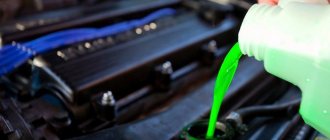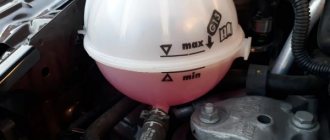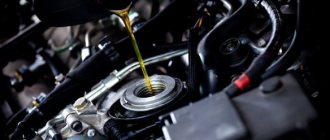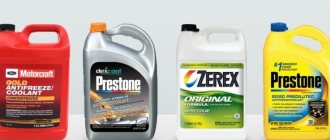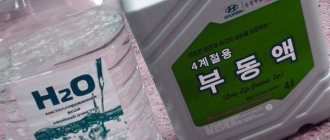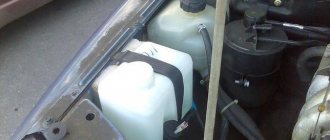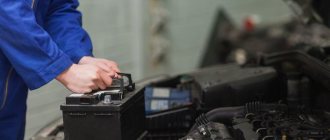A boiling car in the middle of the highway is a driver’s nightmare, which anyone can encounter, especially in the warm season. Untimely replacement of coolant is considered the main cause of failure of the power unit cooling system. Repairing the engine will be too expensive for the vehicle owner; it is easier to remember and know when to change the antifreeze in the car.
Consequences of lack of auto fluid in the system
With the right choice and timely updating, you can avoid serious problems with your vehicle:
The occurrence of corrosion that damages parts made of metal. The corrosive layer disrupts the heat exchange process and reduces the rate of coolant circulation.
Engine overheating, which significantly increases fuel consumption and reduces the power of the power unit.
Sediment from silicate products leading to engine overheating.
Formation of chips and cracks. Often the solution is diluted with water, wanting to save on the purchase of an expensive product. Not all manufacturers allow dilution, since when the temperature changes, the diluted substance freezes and can damage the tank.
Waiting without replacing antifreeze
Missing the problem with harmful antifreeze can lead to the following:
- The process of rusting metal parts. Corrosion not only corrodes the radiator, but also interferes with its normal operation. The developing process deposits numerous layers of rust, which contributes to the disruption of heat transfer.
- Engine overheating. If heat transfer decreases, gasoline consumption increases and the declared power of the car decreases.
- Foreign particles in the form of sediment. This picture can be observed when using silicate antifreeze. In the case where the unfortunate craftsmen performed a poor-quality replacement of the fluid in the radiator. Because of this, a certain sediment is formed, which, when settled, has a bad effect on the operation of the power unit - it overheats.
- Cracks. Adding water to antifreeze, in particular non-distilled water, threatens not only destruction, but also rupture of the expansion barrel. This can happen due to a sharp change in temperature when the mixture freezes and thaws.
- Enhanced vaporization process. The bursting gas bubbles reduce the pressure in the system. The updated antifreeze prevents such processes by forming a protective film that protects against corrosion.
What is coolant
Coolant is a substance that circulates through the components of the power unit and maintains optimal temperature conditions, cooling it if necessary. During movement, engine parts generate large amounts of thermal energy as a result of friction. An uncontrolled increase in temperature provokes overheating of the motor.
How long does it take to replace antifreeze in a car? Engineers have developed a forced circulation system, the main role in which is assigned to antifreeze. Due to its chemical composition, it can encounter and withstand high temperatures without boiling or evaporating. For comparison, water would have to be added every 50 kilometers of driving. This is not just another move by marketers, but a necessity for the normal functioning of every motor vehicle.
How often should the coolant be changed?
Generally accepted recommendations are at least once every 24 months. If you focus on the mileage of the car, then the solution should be drained after 30-45 thousand kilometers. Of course, when changing, you should take into account the condition of the vehicle, its total mileage, and the manufacturer’s recommendations. Silicate-based liquid can be used for up to three years, and hybrid substances retain their unique properties for up to five years. Carboxylate solutions can be used for more than five years and are designed for a mileage of 100 thousand km.
Like any other product, it has its own expiration date, recommendations for storage and use. If storage conditions are violated, it ceases to perform its assigned functions before the date indicated on the label, so it is necessary to constantly monitor its condition.
Methods that help determine when you need to change the antifreeze in your car:
Test strip. This method for determining the condition of an auto fluid is recommended by leading manufacturers. Test strips are sold in all specialized auto stores. The strip should be immersed in a container, after which it acquires a certain shade. The design comes with a color scale so you can easily determine when replacement is needed.
Refrigerant consistency. This method is often used for antifreeze, the optimal density is 1.078 g/cm3. at a temperature of 20 degrees. The waste material has different density indicators.
Color. A suitable coolant has a bright, rich color, which fades and becomes cloudier during use. If the substance is red or tan in color, this indicates the presence of rust and must be replaced urgently.
Presence of foreign substances in the solution. Foam, flakes, chips, and sediment may form in the used product, which indicates its unsuitability for further use.
The above methods will help determine the replacement period in time in order to maintain the working condition of the power unit, prevent serious damage and avoid costly repairs.
Why does antifreeze change color?
The manufacturer has the right to paint the product in any color. There is a generally accepted, but not mandatory, coloring scale:
Let's look at why antifreeze changes color. During operation, additives are produced and a change in coolant color becomes an indicator. For some brands, the indicator is discoloration rather than a change in shade.
Recommendations from manufacturers
Manufacturers always indicate the recommended period for using the liquid on the label. At the end of the specified period, it should be changed, since its unique properties are lost.
How often should you change the antifreeze in your car? Replacement intervals depend on the manufacturing technology of the product and its standard. Automotive industry giant Volkswagen proposed its own classification, which was picked up and actively used by other companies:
G11 (green) - traditional solutions that consist of inorganic silicate compounds and other synthetic elements. The advantage of this class of products is the formation of a special protective layer on engine parts, which prevents the development of corrosion. When using a technical solution longer than the prescribed period, the protective layer precipitates, the level of protection deteriorates, and flakes clog system components. The update interval recommended by the manufacturer is 24 months. Antifreeze has similar qualities, so the recommended period of use is also 2 years.
G12 (red/orange) - standard designating coolants for the manufacture of which organic acids were used. It differs from the traditional type in its heat transfer properties and targeted effect on the source of corrosion, preventing its spread. After the expiration of the permissible service life, the substance loses its properties too quickly, so they must be drained every 5 years.
What do manufacturers offer?
In the store you can find a wide variety of brands of antifreeze. This choice makes my eyes wide open. Manufacturers from any country make coolant according to their own standards. Based on this, the choice is great.
Manufacturers decided to take control of the situation. To help car owners, they divided the available types of antifreeze into classes, according to the Volkswagen concern classification: G11, G12, G13.
Class G11
“G11” is a standard class containing silicate additives. They form a protective layer, slowing down the rusting process, but untimely replacement of “worn out” antifreeze will lead to the formation of sediment. It will not allow the cooling system to work properly; the system elements will overheat.
Class G12
Antifreeze “G12” has a different composition. Here an additive with carboxylic acid becomes an additional component. What does it give? Carboxylic acid protects your metal car parts from corrosion without forming a protective layer, but directly affecting the source of rust development. The longest service life is 5 years, achieved with careful replacement. If you neglect this action and simply top up, then the coolant will not be changed until the car has been in use for 3 years.
Products labeled “G12+” and “G12++” give us pause. The first type means the addition of organic additives, the second is rich in mineral components. Both varieties improve the fluid, but do not affect the timing of replacement.
Class G13
Manufacturers' advice on replacing the presented class comes down to a period of 3 - 5 years. This coolant differs from “G12++” only in the main component – propylene glycol, which significantly increases its cost.
How is antifreeze different from antifreeze?
Antifreeze is one of the types of coolants developed specifically for domestic VAZ vehicles. The trademark was not registered, so over time this concept began to be used by domestic coolant manufacturers. Antifreeze is a domestic analogue, in no way inferior in quality and properties to a foreign product.
It first appeared on store shelves at the same time as the first Lada cars. The name was formed from the abbreviation of the first letters of the department involved in its development - Organic Synthesis Technology. At that time, there were only two classes of “anti-freeze” - A, M. After the marking, two numbers were indicated indicating the temperature at which the product could freeze.
Today antifreeze is available in two versions:
1. Antifreeze-40 (blue tint).
2. Antifreeze-65 (red color).
Colors do not matter; each manufacturer independently determines what color to paint the liquid, since the substance itself is colorless. Coloring is carried out specifically so that the user does not accidentally confuse it with water and ingest it. Antifreeze should never be diluted with plain water, as it destroys the protective properties.
Replacement steps
When you need to change the antifreeze in your car and the replacement time has come, remember that all actions are carried out exclusively on a cold engine. Under no circumstances should you carry out activities on a hot engine, as the temperature can reach 100 degrees.
To change the solution correctly, you should follow a few simple steps:
Prepare a container for draining waste material.
After draining, inspect the hoses, parts, and tank for damage, breaks or cracks. If you find damaged parts, replace them.
Flush the cooling system with a special liquid that removes rust and other stubborn formations. The cleaning agent is poured into the radiator, a little plain water is added to the tank so that it is filled to the very brim.
Start the engine and let it run until it warms up completely and reaches the standard operating temperature.
Turn off the power unit, let it cool, then drain it.
Fill the system with purified water and start the vehicle again. Leave it in working condition for 15-20 minutes.
Turn off the engine, give it time to cool completely and drain the residue again.
After the engine has completely cooled, you can add antifreeze.
Turn on the engine and heating in the cabin so that the coolant can be evenly distributed throughout the cooling system.
After 2-3 days, check the amount of solution and add more substance if necessary.
In order not to harm the vehicle, you should know how often to change it, since replacing antifreeze is carried out strictly according to the recommendations of the manufacturers. If you cannot carry out the prescribed manipulations yourself, seek qualified help from a car service center.
Antifreeze - how to change
Changing antifreeze begins with draining the old one. This is not always easy, for example, look on the Internet for a video of the process on a Scania truck, where truckers are trying to fix problems on the spot.
On a cold engine, remove the tank or radiator cap, insert an unnecessary container, and unscrew the drain plug. The liquid should be completely drained and the system should be cleaned several times (fill with water, turn on the engine for 10 minutes). To obtain the desired effect, it is better to add 20% antifreeze (10% concentrate) or a special substance to the water.
The influence of car mileage on the frequency of changing consumables
Leading automobile companies themselves set the coolant use period. Volkswagen and General Motors provide a lifetime warranty. How often does antifreeze need to be changed in Ford and other vehicles? The company advises updating after reaching 240 thousand km, Auto VAZ - 75,000 km. General Motors, Mazda and Renault even claim that during the operational period of the entire cooling system there is no need to take any measures to maintain it.
If we talk about classes and their relationship with the vehicle’s mileage, then G11 should be filled every 30 thousand km, and solutions of class G12 and G13 - after 40-50 thousand km.
Video "Engine Cooling System"
The video shows how to properly update antifreeze in the engine cooling system. Videos provided by Garage TV channels.
Do you have any questions? Specialists and readers of the AUTODVIG website will help you ask a question
Was this article helpful?
Thank you for your opinion!
The article was useful. Please share the information with your friends.
Yes (100.00%)
No
X
Please write what is wrong and leave recommendations on the article
Cancel reply
Rate this article: ( 5 votes, average: 5.00 out of 5)
Discuss the article:
Recommendations for using coolant on used cars
Engines on used cars in most cases are not in perfect technical condition. Often, the expiration date of consumables on such machines differs significantly from the recommendations for new vehicles.
How often should antifreeze be changed in a high mileage car? It is impossible to name the exact time period for using coolant. It is necessary to independently monitor the condition of the antifreeze using one of the methods suggested above. Antifreeze should be changed immediately if it has been diluted with water or a substance from another manufacturer.
What time of year is best to replace?
Many drivers care about the condition of the cooling system only in the warm season. This opinion is erroneous, because antifreeze protects the vehicle not only from overheating, but also from defrosting. Thanks to its properties, it can withstand temperatures down to -65 degrees. At low temperatures, the solution does not freeze, but turns into a thick mass that reliably protects the power unit from damage.
To ensure normal engine operation, the coolant should be changed prematurely, before the onset of frost.
Why change the coolant?
It is necessary to change the used coolant in your car regularly. Why? Here it is worth going a little deeper into the chemical composition. The main component of the substance is ethylene glycol or propylene glycol (less common due to its high cost). Substances are famous for their extremely low freezing point (crystallization) and have a low expansion coefficient when transitioning from liquid to solid.
At the same time, ethylene glycol promotes corrosion during prolonged interactions with metal components, especially aluminum.
The latter are highly susceptible to the aggressive effects of the compound. To make the antifreeze less volatile, the composition also includes:
- distilled water;
- corrosion inhibitors;
- other additives.
It is the minor elements that lose their properties over time, activating the “destructive” properties of ethylene glycol. And if the car owner does not monitor the health of the radiator, and exhaust gases get inside it, then the protective properties of antifreeze/antifreeze disappear ahead of time. The second reason is the mixing of formulations from different manufacturers and grades.
The key point is adding ordinary water to Antifreeze, which many people do. Often, regular tap water is poured in rather than distillate, which significantly increases the freezing point and increases the susceptibility of metal parts to corrosion. This procedure can help in the summer at a critical moment, but not in the winter. Antifreeze diluted with water thickens greatly in the cold and is no longer able to protect the radiator.
Let's sum it up
Taking into account the above information, it becomes clear that it is necessary not only to change antifreeze according to the regulations, but also to constantly monitor its level and condition, avoid mixing different types of coolant, and also immediately replace the coolant when the slightest sign of a change in its properties appears.
We also recommend reading the article about why emulsion appears on the dipstick when checking the engine oil level. From this article you will learn about the main reasons for the appearance of emulsion on the dipstick and what to do in such a situation.
At the same time, the quality of antifreeze can be assessed by visual inspection. If the antifreeze turns white or cloudy, it needs to be changed urgently. Redness will indicate the presence of rust, while flakes indicate unwanted chemical reactions.
Finally, we note that if the antifreeze has significantly changed its properties, it is necessary to thoroughly and completely flush all engine cooling systems, and parts of the cooling system (pump, thermostat, etc.) may also need verification. The check also cannot be ignored due to the fact that even replacing antifreeze with flushing may not solve the problem of a “sticking” thermostat or clogged radiator channels.
Of course, to avoid such problems, it is better to initially prevent contamination of the system, that is, change antifreeze regularly, use only the types of coolant suitable for a particular engine, recommended by the manufacturer. As a result, both the service life of the antifreeze and all parts of the cooling system are increased.
How is timely replacement useful?
Start systematically changing the antifreeze in your car and get rid of many engine problems, namely:
- corrosion . It not only harms all metal components, but also greatly reduces heat transfer inside the engine. Corrosion layers inside the radiator channels reduce coolant circulation. A similar situation is observed with water pressure in the Soviet water supply of high-rise buildings;
- motor overheating . Violation of heat exchange causes banal overheating of the power plant, which greatly affects fuel consumption and significantly reduces power;
- sediment _ The problem of silicate type antifreezes. Careless replacement of such products contributes to the formation of insoluble sediment deposited on the walls of the radiator and other components. The result is overheating;
- cracks _ Diluting the coolant with an impressive amount of water (especially ordinary water) causes an increase in the freezing point. Sudden temperature changes and constant changes in the state of aggregation of antifreeze (frozen-thawed) will cause cracks in the expansion tank. In the future it may even be torn apart;
- cavitation _ This is the process of gas bubbles appearing in a liquid, which burst and significantly reduce the pressure in the system. The damage appears at the molecular level, but the consequences are no less dire. Fresh coolant creates an invisible enveloping film on the inner surface, protecting against erosion.
Checking the condition of antifreeze: signs of loss of properties and aging of the coolant
Taking into account the above, it becomes clear that the condition of the antifreeze directly affects the overall service life of the parts of the car’s engine cooling system. It is also important that you cannot completely rely on the regulations, since the coolant may lose its properties ahead of schedule. It is important to understand when antifreeze reaches the end of its service life and needs to be replaced.
- First, you need to pay attention to the appearance of the antifreeze. A strong change in the original color is not allowed (even “old” liquid should normally remain red, green, purple, etc.). Noticeable cloudiness of the coolant, the presence of oil stains or emulsion, even on runs of more than 30-40 thousand km, are also unacceptable. Please note that if the antifreeze is “red”, then there is a lot of rust in it. A whitish tint indicates scale accumulation and often indicates sedimentation (usually as a result of mixing different types of coolant).
- If foam and flakes are visible in the antifreeze, in this case such signs indicate a noticeable change in the properties of the coolant.
This antifreeze needs to be changed urgently, since in addition to corrosion and overheating, there is a high risk of blockage of the radiator channels, failure of the pump impeller, etc. In fact, such a liquid has simply become unusable; active chemical processes take place in antifreeze, greatly changing the composition and worsening the properties of the coolant. Let's move on. The antifreeze density should also be normal. To do this, you need to take measurements with a hydrometer. It often happens that during operation the driver adds water to the expansion tank, as a result of which the density of the coolant drops, it can freeze in slight frosts, etc. Of course, if the antifreeze is frozen, plugs may form in the system, etc. In such a situation, you can increase the density, but if the liquid has spent about half of its planned life, it is better to completely replace the TOSOL or antifreeze. - Let us also add that, if necessary, you can check antifreeze using an express test (test strip for checking antifreeze). The strip is lowered into the tank, after which, by comparing it with reference samples, you can determine how long the antifreeze will last by its color. Of course, the method does not provide a 100% guarantee of an accurate determination of the service life, however, with regular checking each season, it is quite possible to understand when to prepare to replace the antifreeze, in a year or after 2-3 months.
How often do you change antifreeze in a car?
There are a number of general recommendations regarding how often to update the coolant in the system. The refrigerant lasts no more than 2 years, or 30-40 thousand kilometers. As for Antifreeze. It needs to be updated based on many factors:
- general condition of the car;
- mileage;
- car make;
- manufacturer;
- compound.
Silicate-based fluids are replaced after 2-3 years, hybrid ones lose their properties after 3-4 years, carboxylate ones continue to last up to 5 years. Recently, carboxylate compounds that can withstand up to 100 thousand mileage have appeared on sale, but their choice is not yet large.
How long does it take to change the antifreeze in the engine?
(to be honest, I think it’s time... I’m interested in another opinion..)
You're right.
If the expansion tank of the cooling system has become brownish-rusty in color, but the mileage on the car is 60,5 years old, is it time to change the antifreeze?
Antifreeze changes not only because of color, it loses its properties and additives stop working
what the hell is the frequency?! the system is always leaking, so the antifreeze is refreshed weekly, monthly, daily (choose to taste)
By the way, how did you make the radiator or not?
I also have a leak and figured it out today. I didn’t bother, I bought a composition for repairing Hi-Gear cooling systems and barked, plus I changed the expansion valve. Let's see what happens tomorrow. ))))
Just having read that I didn’t want to bother with changing the heater radiator)))))))0 although I might have to if this elixir doesn’t help.
We also read this in books, but in practice, pumps and radiators fly the same way with old antifreeze or with new, expensive imported antifreeze.
By the way, how did you make the radiator or not?
I also have a leak and figured it out today. I didn’t bother, I bought a composition for repairing Hi-Gear cooling systems and barked, plus I changed the expansion valve. Let's see what happens tomorrow. ))))
Just having read that I didn’t want to bother with changing the heater radiator)))))))0 although I might have to if this elixir doesn’t help.
did. It’s just that, damn, I didn’t combine the two flaps in a hurry, now I have to climb again, but the problem is much less complicated or anything, if you don’t need to remove the panel, if necessary - screw it - it’s better to go to the service. we were drunk for 5-6 hours. At the same time I replaced the pipes and a bunch of clamps.
Source
We detect loss of refrigerant properties
The manufacturer claims a certain “working” time for the coolant, but the special properties may be lost earlier. It is necessary to periodically check the condition of the antifreeze, for which there are several methods:
- test strips . The process is simple and rational. The strips are purchased in the same place as the cooler. When immersed in liquid, a reaction occurs with the characteristic coloring of the tester in the corresponding color. Also included is a detailed color scale, which can be used to determine how long the antifreeze will last;
- consistency . The most acceptable density of Antifreeze is 1.078 g/cm3 at a temperature of 20 degrees Celsius. This temperature is optimal for measurements. If your fluid is not up to standard, it is worth changing;
- color . Antifreeze is initially very bright. If it fades, becomes cloudy and faded, then the liquid has already done its job. The appearance of a reddish or rusty tint indicates the presence of rust in the system;
- dense particles . Foam, sediment, “flakes” and scale chips are signs of fluid incompetence. If a kind of “porridge” is noticeable on the surface of the expansion tank, you need to urgently change the refrigerant.
If you don't know how often to change your antifreeze, follow these tips and regularly check the performance and condition of the coolant. It will demonstrate its suitability for further use.
Recommendations for replacing antifreeze
Having figured out how long it takes to change the antifreeze in a car, novice car enthusiasts usually have the question of how to cope with the task on their own without involving third-party services and technicians, whose services are expensive. In fact, coping with the task is not at all difficult if you know the procedure for completing it:
- The car is placed on a horizontal platform and allowed to cool properly after work, otherwise you can easily get burned, since the temperature of the technical fluid in the radiator, expansion tank, engine block and other elements can reach 90-96 degrees Celsius.
- Open the drain hole or disconnect the lowest pipe from the radiator if the car design does not provide a separate antifreeze drain point (most often relevant for domestically produced cars).
- It is strongly recommended to drain the antifreeze completely, especially if the owner plans to fill in a different class of refrigerant. To do this, you need to close the expansion tank, leaving the drain or pipe open, turn on the stove at full power and start the engine.
- After several minutes of operation, the engine is turned off, since longer operation without technical fluid in the system is fraught with overheating and deformation of individual elements.
- If antifreeze continues to drip from the drain hole, the procedure must be repeated after some time in order to create additional pressure to expel it from the system.
- The entire system is washed with distilled water, which will help remove the remaining old refrigerant (relevant when switching to a new coolant class).
- The drain or pipe is closed. Open the cap of the expansion tank and fill it with new antifreeze to the maximum mark.
- Turn on the stove, start the engine and give the car some time for all its systems to fill with antifreeze, after which they check its level in the tank, which must be filled to the maximum.
- The procedure is repeated as many times as necessary until antifreeze stops leaving the tank.
- After a few days of intensive use, a control check of the antifreeze in the tank is carried out and, if necessary, the required volume is refilled.
And if you follow the above instructions, the car will serve its owner faithfully for many years.
Is it necessary to change the coolant and why?
The main thing in the composition of this liquid is additives. Over time, they lose their properties and elements of the coolant, such as ethylene glycol and water, begin to have a corrosive effect. If you do not change the antifreeze within 6 months, a hole may form in the car's radiator due to electrolyte corrosion.
Rust particles formed in antifreeze can cause:
- incorrect operation of the thermostat;
- destruction of the pump impeller;
- radiator clogged;
- contamination of engine channels;
- depressurization of the pump bearing.
Such failures lead to engine overheating. At first, engine overheating will be expressed in increased fuel consumption, the next stage is a decrease in its power. As practice shows, engine overheating causes a reduction in its service life by 2 or 3 times.
Important qualities of antifreeze:
- Low temperature. Cooling the car engine and maintaining its average temperature.
- Protection. Protecting the engine from overheating, corrosion, destruction and hypothermia.
- Lubrication. The liquid is the lubricating element of the car pump.
About additives
As I wrote above, they contain the secret formula , and because of them, it is precisely the antifreeze or antifreeze that needs to be changed after a certain mileage.
If you leave only ethylene glycol (propylene glycol) + distilled water . This composition will work - but it is extremely aggressive . That is, after a short mileage, it will begin to corrode your pipes, radiators, pump, thermostat, and even the engine block (it corrodes aluminum well, as well as various gaskets).
To prevent this from happening, manufacturers began adding additives to the composition. They, so to speak, neutralize the “aggressive nature” of the coolant.
But the additives (if you don’t go too deep inside, they differ “specifically”), there are three types in total:
- Inorganic additives - usually phosphates, borates, silicates, nitrites, and many others
- Organic additives - usually use carboxylic acid, hence the name "carboxylate"
- Hybrid is the most advanced type; two types are used here: organic and a small part of inorganic substances. In simple words, we found a formula that will combine two types in one at once.
So, you need to change antifreeze or antifreeze precisely because of what additives are used in your composition. They all work, different periods of time
We detect loss of refrigerant properties
There are some parameters by which you can determine how long it is time to replace antifreeze:
- cloudy color;
- sediments in the form of rust, foam, scale particles and other formations in the liquid;
- decrease in coolant level.
If you find at least one point in the tank, you should understand that it’s time to worry about changing the antifreeze.
One of the most effective methods for determining the quality of coolant is the use of special test strips, which, when immersed in a tank of antifreeze, acquire a certain shade.
How to determine if antifreeze is unsuitable
There are several methods for diagnosing coolant. Their knowledge will be especially useful for owners of used cars. The following methods are known:
- Test strip. Such devices are usually sold in the same place where antifreeze and antifreeze are sold. The diagnostic procedure is simple - the strip is lowered into the liquid and then removed. The result is judged using the attached color scale.
- Visual definition. If turbidity or the formation of a whiter color is detected, the fluid should be replaced. Also, a sign of loss of antifreeze properties will be brownish-reddish colors, which characterizes the corrosion process. Rust floats in liquid. This situation should also be corrected immediately.
- Foreign particles. The detection of sediment and foam in the expansion tank tells us the urgency of replacing the fluid with a complete flushing of the system.
- Consistency. If the density of antifreeze deviates from the norm - 1.078 g/cm3, then it should be changed.
How often should I replace?
The period when it is necessary to change the coolant in the system cannot be unambiguous. The timing of antifreeze replacement depends on the operating conditions of the machine and on the properties of the coolant itself. General recommendations provide for the procedure to be carried out after every 40 thousand km of travel (or at intervals of two years).
The time to replace antifreeze in a car is affected by:
- general condition of the car;
- mileage;
- car make;
- antifreeze manufacturer;
- coolant composition.
Antifreeze classification
Each class of coolant has its own recommendations for replacement in a car.
- G11 (green) - must be replaced at least once every two years.
- G12 (red) - before replacing antifreeze of this class, you need to flush and dry the cooling system. If this stage is followed, the next replacement can be carried out after 5 years. If the system was not flushed and coolant was added during operation, the coolant should be changed after 3 years.
- G13 - this class is similar in terms of antifreeze service life to class G12. The service life of the fluid varies from 3 to 5 years, depending on the conditions of the previous replacement.
- Antifreeze - the frequency of replacing domestically produced coolant is less than 2 years. It is necessary to regularly check the level and condition of antifreeze in the expansion tank.
Recommendations from car manufacturers
The cooling system service intervals for each vehicle are determined by the manufacturer and are indicated in the operating instructions.
Some argue that a change will not be required throughout the entire service life, others recommend changing the coolant every few years, for example:
- Volkswagen and General Motors give a lifetime period for replacing antifreeze in a car;
- Ford gives ten years or 240,000 km;
- Mercedes-Benz - five years;
- AvtoVAZ - 75,000 km;
- BMW and Mitsubishi recommend changing antifreeze every 4 years;
- Daimler - once every fifteen years;
- in General Motors, Mazda and Renault cars, a change is not required throughout the entire life of the car.
However, new antifreeze production technologies make it possible to change it even after traveling a distance of 250,000 kilometers, given that at the time of replacement the system was washed and dried. Manufacturers also strongly recommend not mixing liquids from different brands and classes.
If the car’s engine is worn out or the car is subjected to intense loads, then, according to the recommendations of auto mechanics and car manufacturers, replacing the coolant of domestic production and class G11 should occur after 30,000 km. If it is a higher level of antifreeze, then it is permissible to change it every 50,000 kilometers.
Antifreeze: change or top up?
The additives stop working, the water evaporates, and periodic renewal is needed. If you add only distillate, there will not be enough substances to protect the system.
If the level is low, check the system for leaks. If none is found, it is worth topping up.
Compatibility of compositions of the same color is optional (see above). To choose the right coolant, you need to follow the car manufacturer's recommendations. Different liquids should not be mixed. The reason is that additives can neutralize each other and react. Such a substance will not protect/cool.
